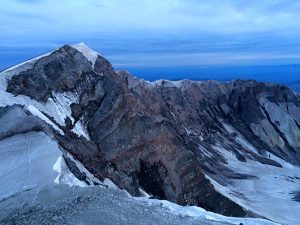Where were you on May 18, 1980? Longtime residents of the Inland Northwest remember that day that Mount St. Helens erupted, blowing 520 million tons of ash into the atmosphere and bringing darkness to the region in the middle of the day. Thirty-five years after the big explosion, I visited the famous summit with some friends. We planned our trek near the summer solstice to take advantage of the long daylight hours. One of us had suggested summiting at sunrise, and, being romantics at heart, we all agreed enthusiastically. Of course, that meant that we’d start hiking at midnight, when our 24-hour permits became active.
Climbing permits are inexpensive ($22 each), but they sell out quickly for the most popular days of the year. Between May 15 and October 31, permits are limited to 100 lucky souls per day. We pounced on tickets the day they went on sale in February and then followed the reports on the Washington Trails Association website each month. Saner people than us cheerfully described starting their hikes in the morning and appreciating their mountaintop experiences with plenty of energy to enjoy the descent.
Finally, after a full day at work in mid-June, we drove across the state, grabbing a dinner burrito on the way out of town, and arrived at the trailhead at 11:30 p.m. A half hour later we set out, headlamps alight and senses alert. The first two miles were downright pleasant. The soft trail gently rose 900 feet through a forest of firs. Every now and then our headlamps would catch the reflection of wildlife’s eyes far up or down the trail.
After mile two, we passed out of the trees and into the boulder field — rocks the size of Hummers made of skin-slicing pumice. Without gloves, our hands would have been hamburger. Every 100 yards or so, posts with varying degrees of reflectivity marked the trail, but for eight people in the dark on an unfamiliar trail, the posts mocked us as each came into view and then passed out of sight. Vertigo visited some of us as we repeatedly looked up and away at the next trail post, then immediately ahead at the next big boulder, then down and behind at the person following.

One mile farther, one hour later, 800 feet higher, but with energy levels significantly lower, we continuously took two scrambles up and one slide down, because the granulated pumice created a steep, sand dune-like ascent that was difficult to gain a purchase on. Eventually, our headlamps weren’t necessary. We had 25 minutes until sunrise, and 150 feet to the summit. With just moments to spare, we arrived at the top, where there were still a few inches of ashy, crusty snow.
Now without a windshield, we blinked into the east. Thin, hazy clouds obscured the horizon, but by then we simply trusted that the increasing light was coming from the sun. Turning in a standing circle, we took in the now-eye-level peaks of neighboring Mount Adams, Mount Hood, and Mount Rainier. We walked carefully along the rim of the crater. At a safe distance from the cornice, we observed a tiny stream of steam rising from the crater and heard soft gasps beneath the surface.
By now our sweat had cooled and our heart rates had leveled, so we started our descent. Our thighs screamed from the hours of vertical lunges we’d just completed. Some hikers glissade back down the nearby snowfields, but the early hour made those too icy, so we slid down the pumice dunes by foot. Once we arrived back at the boulder fields, I did a mile-long series of triceps dips, bracing my hands and arms against boulders and lowering myself down. Finally below the tree line, we zombie-stumbled down the last two miles. The two sufficiently conscious people in our group drove the rest of us back to town, where we all slept for 15 hours straight. I’m usually a morning person, and I love finding that place on a trail where you can’t step any higher. But a sleepless sunrise summit on an unfamiliar peak? //
Janelle McCabe is a Jill-of-some-trades, master-of-none who writes about the Inland Northwest outdoor and active community. She wrote about backyard beekeeping in June.













